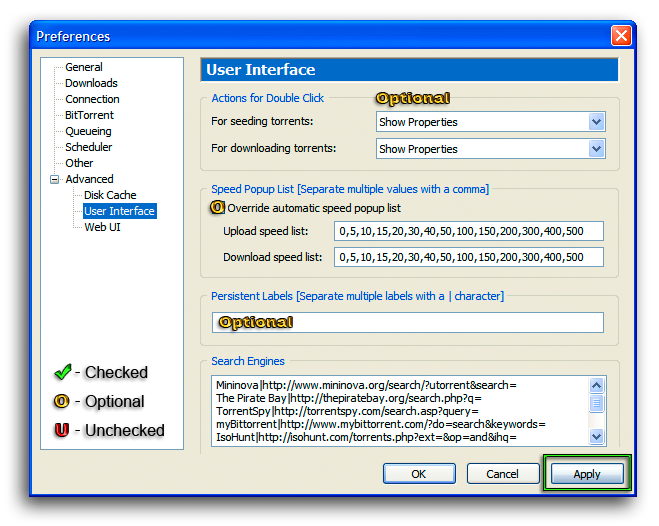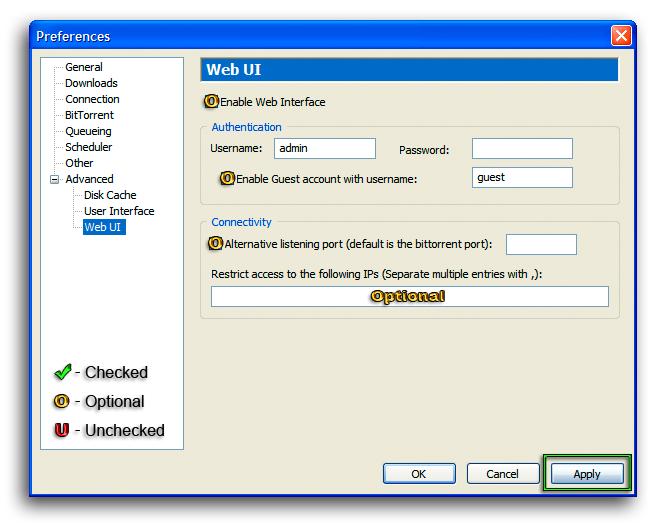uTorrent Installation, Setup and Optimization, page 2

slash ProDanceCulture
on September 3rd, 2011
/ post 40649

slash ProDanceCulture
on September 3rd, 2011
/ post 40650

User Interface
Actions for Double Click
For seeding torrents: - This setting enables the user to select the action that µTorrent takes, when double-clicking a seeding torrent,
in the Main µTorrent program window.
For downloading torrents: - This setting enables the user to select the action that µTorrent takes, when double-clicking a downloading torrent,
in the Main µTorrent program window.
The following options can be set from the "Drop Down" menu.
Show Properties - The "Torrent Properties" window will open.
Start / Stop - Changes the condition of the double-clicked torrent (either Start or Stop).
Open Folder - Opens the "Containing Folder" of the double-clicked torrent.
Show Download Bar - Displays a torrent information bar "Always on top", on the Desktop.

Speed Popup List
Override automatic speed popup list - When enabled, the user can define the lists, of speeds displayed, when "Right-Clicking"
the corresponding item on the status bar, in the Main µTorrent program window. If left unchecked, µTorrent will automatically generate a list,
based on the current limit.
Upload speed list - The user defined "Upload Speed" list. Each value (in kB/s) must be separated with a comma;
no spaces should be used. "-1" adds a separator to the list. Zero "0" adds "Unlimited".
Any other positive value is interpreted normally (as that value).
Download speed list - The user defined "Download Speed" list. Each value (in kB/s) must be separated with a comma;
no spaces should be used. "-1" adds a separator to the list. Zero "0" adds "Unlimited".
Any other positive value is interpreted normally (as that value).
Persistent Labels
Enables the user to specify a permanent label regardless of the number of torrents, which are actually using that label.
Multiple persistent labels may be entered, but must be separated with a " | " (vertical pipe). Persistent labels are given higher priority
than normal labels in the category list, so correspondingly, they are displayed above their normal counterparts.
Search Engines
Clicking the µTorrent "Search Button" displays a drop down menu allowing the user to select a search engine, from this list.
To search, type the query into the "Search Field", click the Search Button to choose the desired site and press "Enter" on the keyboard.
The µTorrent built-in Search facility will open a window or tab, in the default browser, and display the desired search.
Search Engine Format: Name|https://domain/path?search=
Example: Waffles|https://www.waffles.fm/browse.php?cat=0&incldead=1&titleonly=1&search=

slash ProDanceCulture
on September 3rd, 2011
/ post 40651

Web UI
µTorrent can be use remotely from any computer, via the µTorrent Web UI (User Interface) and a web browser, through the port designated for BitTorrent transfers. Not every feature is available to the Web UI, but most are accessible including, "Add" by either uploading a .torrent file, or by entering the torrent URL, "Start", "Stop", "Remove" and changing bandwidth settings.
To use the µTorrent Web UI the file "webui.zip" must be placed "as is" (still zipped) in the same folder as µTorrent's "settings.dat" file, by default at:
C:\Documents and Settings\*User Account*\Application Data\µTorrent
The file "webui.zip" can be downloaded here; included in the "webui_v0.310_beta_2.rar" download, are webui.zip, µTorrent.exe and additional instructions.
Once enabled and properly setup, the µTorrent Web UI can be accessed using the system’s IP address and µTorrent listening port.
From a remote location simply open the web browser and enter in the address bar "https://Home System IP: Port/gui/"
i.e. https://123.456.78.90:52000/gui/ If you use a dynamic DNS Service, your domain may be used instead of the IP address.
Enable Web Interface - When enabled the µTorrnet Web UI will be available for remote use.
Authentication
Username - Enables the use of a specific "Username" with which to log in from a remote location, adding an additional layer of security.
The default is "Admin".
Password - Used to define a "Password" for the specificied "Username". This field may be left blank if a password is not desired.
Enable Guest account with username: - When enabled the "Guest Account" is activated. When enabled, a "Username" for the "Guest Account" must be specified. A "Guest" may view (but not edit) the torrents currently in µTorrent.
Connectivity
Alternative listening port (default is the bittorrent port): - When enabled, the user can set a port specific to Web UI requests; this option is especially valuable when using "Randomize port each time µTorrent starts". The "Alternative" listening port must be forwarded manually, even if "UPnP" is used to forward the normal µTorrent port. If left disabled, µTorrent will serve the Web UI over the normal listening port.
Restrict access to the following IPs (Separate multiple entries with ,): - Allows the user to limit the IPs which can connect to the web interface. Multiple IPs may be specified, but must be separated by commas. IP ranges may be set using "Classless Inter-Domain Routing" (CIDR) notation; i.e. "xxx.xxx.xxx.xxx/n" where [xxx.xxx.xxx.xxx] is the IP Address and [n] is the number of (left most) '1' bits in the mask.

you cannot post in this forum.
click here to to create a user account to participate in our forum.
click here to to create a user account to participate in our forum.
Top 20 Torrents (last 25 days)» John Digweed - Compiled & Mixed 31 - 05-Apr-2024 » Hernan Cattaneo - Live @ BNP x Sinner, Vagalume (Tulum, Mexico) - 23-Jan-2024 » Pole Folder - Balance Selections 279 [HQ] - April 2024 » Guy J - Live at Racos Volcano (Romania) - 25-Jun-2022 » Lee Burridge - Robot Heart - Burning Man [HQ] - August 2023 » John Digweed - Transitions 1022 (Guest Monty Luke) - 29-Mar-2024 » John Digweed - Transitions 1024 (Guest Works Of Intent) - 12-Apr-2024 » Steve Lawler - Live @ PENDULUM, Do Not Sit on the Furniture (Miami, USA) - 06-Apr-2024 » Moshic - DJ Mix - April 2024 » John Digweed - Transitions 1023 (Guest Nickon Faith) - 05-Apr-2024 » Anthony Pappa & Eric Powell - Live at Kubik (Frankston, Melbourne) - 07-Apr-2024 » John Digweed - Transitions 1025 (Guest Helsloot) - 19-Apr-2024 » Jonathan Kaspar - Live at Stereo Montreal - All Night Long [HQ] - 05-Apr-2024 » Anthony Pappa - Live at Virtue & Vice, Melbourne - 12-Apr-2024 » HERNAN CATTANEO - Live at Freshwave Festival (Part 1) - 12-Aug-2022 » Joris Voorn & Kolsch - Live @ Ultra Music Festival Miami 2024 (Day 2) - 23-Mar-2024 » Quivver - Controlled Substance #60 - April 2024 » Kintar - Live @ Summerians - Savaya Bali [HQ] - April 2024 » Dave Seaman - Radio Therapy Broadcast [HQ] - April 2024 » Ame - Live @ Timewarp - 05-Apr-2024
Recent from the Forum (Be Social)» hey, lottery winners!!! post your testimonials!!! 1d 23h » Friday, April 26th IMS Dalt Vila Ibiza » Here are 3 choices for reliable site in the field of online video converters » Torrents Recommended for REMOVAL by Staff » April 12-14 & April 19-21 Coachella Indio » Nick Warren - Forja Cordoba 2024 » April 6th - Time Warp Mannheim » I can't download » April’s Fool Mystery » March 22nd - 24th Ultra Music Festival Miami
Disk Cache
The disk cache is used to keep frequently accessed data in memory, to reduce the number of "Reads & Writes" to the hard drive.
µTorrent normally manages the cache automatically, but you may change its behavior by modifying these settings.
Disk Cache
Override automatic cache size and specify the size manually: - Enables the user to set a new maximum memory usage for the disk cache. Normally, µTorrent automatically adjusts the cache size based on current download speed.
Reduce memory usage when cache is not needed - Clears the disk cache when µTorrent is not transferring data.
This option should not be used if you wish to minimize disk access.
Advanced Cache Settings
Enable caching of disk writes - When enabled, µTorrent will decrease the frequency of disk writes, by storing data in memory before writing to disk.
This has the effect of decreasing the frequency of reads from disk.
Write out untouched blocks every 2 minutes - When enabled, µTorrent will write to disk, 16 KB blocks of data in memory,
that haven't been touched for 2 minutes. This option should not be used if you wish to minimize disk access.
Write out finished pieces immediately - When enabled, µTorrent will write a piece to disk once it is completed in memory.
This option should not be used if you wish to minimize disk access.
Enable caching of disk reads - When enabled, µTorrent will use the disk cache to store frequently read data into memory, from disk.
This has the effect of decreasing the frequency of reads from disk.
Turn off read caching if the upload speed is slow - When enabled, µTorrent will disable read caching, if upload speed is below 40 KB/s.
This lowers memory usage when the cache is not needed. This option should not be used if you wish to minimize disk access.
Remove old blocks from the cache - When enabled, µTorrent will remove chunks of read cache data, from memory if they have not been
accessed for 10 minutes. This option should not be used if you wish to minimize disk access.
Increase automatic cache size when cache thrashing - When enabled, µTorrent will increase the cache size, when the "Reads" from disk
increase (most often due to increased upload speeds). If you override the automatic cache size, this option is not needed.